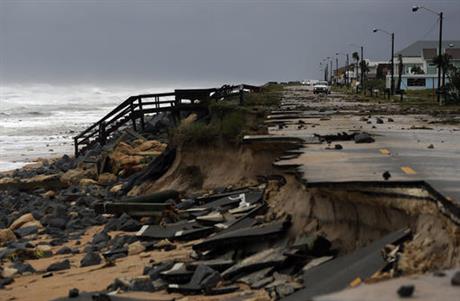CHARLESTON, S.C. (AP) — A weakening Hurricane Matthew continued its march along the Atlantic coast Saturday, lashing two of the South’s most historic cities and some of its most popular resort islands, flattening trees, swamping streets and knocking out power to hundreds of thousands.
The storm was blamed for at least four deaths in the U.S., all in Florida. In its long wake, it also left well over 300 people dead in Haiti.
Matthew raked the Georgia and South Carolina coasts with torrential rain and stiff winds. But just as it did during its long trek up the Florida shoreline, its center, or eye, mercifully stayed just far enough offshore that coastal communities didn’t feel the full force of its winds.

At 9 a.m., Matthew was centered about 30 miles southeast of Charleston, its winds having dropped to 75 mph, a Category 1 storm. That was down from 145 mph when the storm roared into Haiti. It was moving at 12 mph.
Among the cities bracing for its effects later in the day were Myrtle Beach, South Carolina, and Wilmington, North Carolina.
Matthew brought some of the highest tides on record along the South Carolina coast. Streets and intersections in historic Charleston — a city of handsome pre-Civil War homes, church steeples and romantic carriage rides — were flooded.
Leigh Webber watched the torrential rains from the porch of her home in the city’s historic district.
“It’s not as bad as maybe I was expecting,” she said.
“I feel badly for a lot of the businesses downtown that have been closed since Wednesday,” she added. “I noticed a lot of hotels were completely closed. I know some weddings were canceled and it was a huge financial loss for a lot of people.”
South Carolina’s golf-and-tennis resort Hilton Head Island also took a blow as the eye of the storm passed 20 miles to the east. At least one gust of 87 mph was recorded at Hilton Head.
The two roads onto the island of 40,000 people were blocked by fallen trees, and many roads were under water. Signs were blown over, and power was out across the island.
Chandler Brunson and was among those trying to go back to her home after evacuating, but found her path blocked.
“I think we’re going to have a pine tree splitting our house,” she said. “That’s what I’m afraid of.”
The storm also lashed Savannah, Georgia, another historic town of moss-draped squares and antebellum mansions.
Residents of Brunswick, Georgia, woke to roads covered by water or fallen trees and downed power lines. All access points to nearby St. Simons Island from the mainland were blocked.
More than 150,000 electric customers in South Carolina were without power, and 250,000 were in the dark in coastal Georgia. Matthew was expected to near North Carolina’s southern coast by Saturday night.
“Now is the time we ask for prayer,” Gov. Nikki Haley said, bowing her head.
Matthew — the most powerful hurricane to threaten the Atlantic Seaboard in more than a decade — set off alarms as it closed in on the U.S.
But in the end, it skirted Florida’s heavily populated Miami-Fort Lauderdale-West Palm Beach area, and sideswiped the cities farther north, including Daytona Beach, Vero Beach, Cape Canaveral and Jacksonville, without its center ever actually coming ashore.
Well south of the storm, things quickly began returning to normal, with all three of Orlando’s main theme parks — Walt Disney World, Universal Studios and SeaWorld — reopening Saturday morning.
In Georgia, Steve Todd defied orders to evacuate Tybee Island even after the mayor called and pleaded with him to leave. As conditions rapidly deteriorated Friday night, with trees bending and the rain falling sideways, Todd wasn’t sounding quite so bold.
“I’m not regretting staying,” Todd said by telephone. “But I’m not going to lie: There’s a little bit of nervous tension right now.”
In Florida, the storm gouged out several large sections of the coastal A1A highway north of Daytona Beach.
“It’s pretty bad; it’s jagged all over the place,” said Oliver Shields, whose two-story house is within sight of the highway.
The deaths in Florida included an elderly St. Lucie County couple who died from carbon monoxide fumes while running a generator in their garage and two women who were killed when trees fell on a home and a camper.
On Friday, the storm raked yet another historic Southern city: St. Augustine, Florida, which was founded by the Spanish in the 1500s and includes a 17th-century stone fortress and many historic homes turned into bed-and-breakfasts. The city left awash in rain and gray seawater.